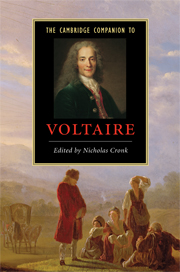Book contents
- Frontmatter
- Introduction
- 1 The making of a name: a life of Voltaire
- 2 Voltaire and authorship
- 3 Voltaire: philosopher or philosophe?
- 4 Voltaire and clandestine manuscripts
- 5 Voltaire and the myth of England
- 6 Voltaire’s masks: theatre and theatricality
- 7 Voltaire as story-teller
- 8 Candide
- 9 Voltaire and history
- 10 Voltaire’s correspondence
- 11 Voltaire: pamphlets and polemic
- 12 Voltaire and the politics of toleration
- 13 Voltaire and the Bible
- 14 The Voltaire effect
- Further reading
- Index
10 - Voltaire’s correspondence
Published online by Cambridge University Press: 28 May 2009
- Frontmatter
- Introduction
- 1 The making of a name: a life of Voltaire
- 2 Voltaire and authorship
- 3 Voltaire: philosopher or philosophe?
- 4 Voltaire and clandestine manuscripts
- 5 Voltaire and the myth of England
- 6 Voltaire’s masks: theatre and theatricality
- 7 Voltaire as story-teller
- 8 Candide
- 9 Voltaire and history
- 10 Voltaire’s correspondence
- 11 Voltaire: pamphlets and polemic
- 12 Voltaire and the politics of toleration
- 13 Voltaire and the Bible
- 14 The Voltaire effect
- Further reading
- Index
Summary
Voltaire's correspondence is arguably his masterpiece. No one would now suggest, as scholars once did, that 'it is to be read, not to be studied'; nonetheless the study of the correspondence poses many problems, for each single letter needs to be analysed with respect to its date and to the relationship between author and addressee. Generalisations are therefore unsafe, but this enormous corpus of letters remains at the heart of current research into Voltaire.
The creation of the corpus
The great novelty of the Kehl edition (1784-9), the first edition of Voltaire's complete works published after his death in 1778, was that it was the first to include correspondence (some 4,500 letters in all); in the view of the editors, the presence of the letters in the edition was designed to show that 'the greatest of writers was also the best of men' ('le plus grand des écrivains fut aussi le meilleur des hommes'): behind the marketing publicity for the edition lay an evident concern with the great man's posthumous reputation. The correspondence has figured in every complete edition of Voltaire's works ever since. The Beuchot edition, in the early nineteenth century, brought together 7,500 letters, and the tally had reached 10,000 in the Moland edition by the end of the century. The standard edition of reference is now that of Theodore Besterman, whose 'definitive edition', which includes letters written to Voltaire and also selected letters by third parties about Voltaire, reaches a total of 21,222, of which over 15,000 are by Voltaire himself.
- Type
- Chapter
- Information
- The Cambridge Companion to Voltaire , pp. 153 - 166Publisher: Cambridge University PressPrint publication year: 2009
- 2
- Cited by

